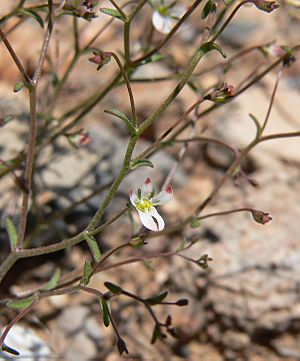Glandular threadplant facts for kids
Quick facts for kids Glandular threadplant |
|
|---|---|
 |
|
| var. orientalis | |
| Scientific classification | |
| Kingdom: | |
| (unranked): | |
| (unranked): | |
| (unranked): | |
| Order: | |
| Family: | |
| Genus: |
Nemacladus
|
| Species: |
N. glanduliferus
|
| Binomial name | |
| Nemacladus glanduliferus Jeps.
|
|
The Nemacladus glanduliferus is a type of flowering plant in the bellflower family. It is commonly known as the glandular threadplant. This plant grows naturally in the southwestern United States and Baja California in Mexico. You can find it in dry desert areas and high, flat plateaus.
The glandular threadplant is an annual plant, meaning it lives for only one year. It has a stem that can be purplish or brownish-green and grows up to about 25 centimeters (about 10 inches) tall. This stem has many branches. Its small, oval-shaped leaves grow near the bottom of the plant.
What Does the Glandular Threadplant Look Like?
The flowers of the glandular threadplant grow on thin, upright stalks called pedicels. These stalks branch out in a zigzag pattern. Each pedicel has a tiny leaf-like part called a bract at its base.
The flowers are very small, only a few millimeters wide. They grow at the curved end of the pedicel. Each flower has five pointed sepals, which are like small leaves that protect the bud. It also has five white petals, called corolla lobes. Usually, three petals form an upper 'lip' and two form a lower 'lip'.
Where Does it Grow?
The glandular threadplant is found in the dry regions of the southwestern United States. This includes parts of California and Arizona. It also grows in the Baja California Peninsula in Mexico. It prefers habitats like deserts and high, flat areas called plateaus.

